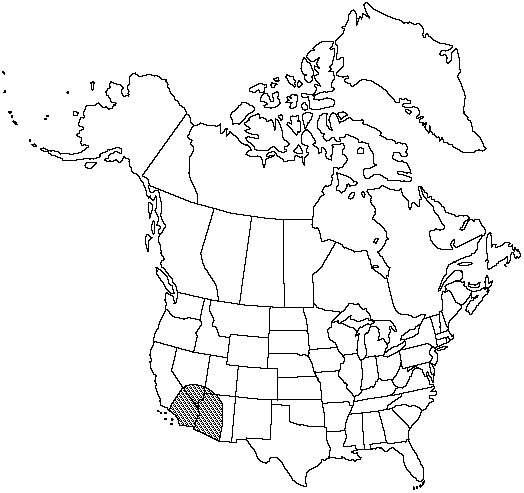Difference between revisions of "Cheilanthes parryi"
Biblioth. Bot. 20(85): 133. 1915.
FNA>Volume Importer |
FNA>Volume Importer |
||
| Line 20: | Line 20: | ||
}}<!-- | }}<!-- | ||
| − | --><span class="statement" id="st- | + | --><span class="statement" id="st-undefined" data-properties=""><b>Stems </b>compact to short-creeping, 3–10 mm diam.; scales often uniformly brown but at least some on each plant with well-defined, dark, central stripe, linear-lanceolate, straight to slightly contorted, loosely appressed, persistent. <b>Leaves</b> clustered, 4–20 cm; vernation circinate. <b>Petiole</b> dark brown to black, rounded adaxially. <b>Blade</b> lanceolate to linear-oblong, usually 2-pinnate-pinnatifid at base, 1–4 cm wide; rachis rounded adaxially, lacking scales, with dense monomorphic pubescence. <b>Pinnae</b> not articulate, dark color of stalk continuing into pinna base, basal pair usually smaller than adjacent pair, ± equilateral, appearing densely villous adaxially. <b>Costae</b> brown adaxially for most of length; abaxial scales absent. <b>Ultimate</b> segments oblong to lanceolate, not beadlike, the largest 3–5 mm, abaxially and adaxially densely villous with long, segmented hairs. <b>False</b> indusia absent. <b>Sori</b> ± continuous around segment margins. <b>Sporangia</b> containing 64 spores. <b>2n</b> = 60.</span><!-- |
-->{{Treatment/Body | -->{{Treatment/Body | ||
| + | |phenology=Sporulating late spring–fall. | ||
|habitat=Cliffs and ledges, on a variety of substrates including limestone and granite | |habitat=Cliffs and ledges, on a variety of substrates including limestone and granite | ||
|elevation=100–2300 m | |elevation=100–2300 m | ||
| Line 42: | Line 43: | ||
|basionyms=Notholaena parryi | |basionyms=Notholaena parryi | ||
|family=Pteridaceae | |family=Pteridaceae | ||
| + | |phenology=Sporulating late spring–fall. | ||
|habitat=Cliffs and ledges, on a variety of substrates including limestone and granite | |habitat=Cliffs and ledges, on a variety of substrates including limestone and granite | ||
|elevation=100–2300 m | |elevation=100–2300 m | ||
| Line 49: | Line 51: | ||
|publication year=1915 | |publication year=1915 | ||
|special status= | |special status= | ||
| − | |source xml=https://jpend@bitbucket.org/aafc-mbb/fna- | + | |source xml=https://jpend@bitbucket.org/aafc-mbb/fna-data-curation.git/src/9216fc802291cd3df363fd52122300479582ede7/coarse_grained_fna_xml/V2/V2_474.xml |
|genus=Cheilanthes | |genus=Cheilanthes | ||
|species=Cheilanthes parryi | |species=Cheilanthes parryi | ||
| − | |||
| − | |||
| − | |||
| − | |||
| − | |||
| − | |||
| − | |||
| − | |||
| − | |||
| − | |||
| − | |||
| − | |||
| − | |||
| − | |||
| − | |||
| − | |||
| − | |||
| − | |||
| − | |||
| − | |||
| − | |||
| − | |||
| − | |||
| − | |||
| − | |||
| − | |||
| − | |||
| − | |||
| − | |||
| − | |||
| − | |||
| − | |||
| − | |||
| − | |||
| − | |||
| − | |||
| − | |||
}}<!-- | }}<!-- | ||
-->[[Category:Treatment]][[Category:Cheilanthes]] | -->[[Category:Treatment]][[Category:Cheilanthes]] | ||
Revision as of 13:21, 27 July 2019
Stems compact to short-creeping, 3–10 mm diam.; scales often uniformly brown but at least some on each plant with well-defined, dark, central stripe, linear-lanceolate, straight to slightly contorted, loosely appressed, persistent. Leaves clustered, 4–20 cm; vernation circinate. Petiole dark brown to black, rounded adaxially. Blade lanceolate to linear-oblong, usually 2-pinnate-pinnatifid at base, 1–4 cm wide; rachis rounded adaxially, lacking scales, with dense monomorphic pubescence. Pinnae not articulate, dark color of stalk continuing into pinna base, basal pair usually smaller than adjacent pair, ± equilateral, appearing densely villous adaxially. Costae brown adaxially for most of length; abaxial scales absent. Ultimate segments oblong to lanceolate, not beadlike, the largest 3–5 mm, abaxially and adaxially densely villous with long, segmented hairs. False indusia absent. Sori ± continuous around segment margins. Sporangia containing 64 spores. 2n = 60.
Phenology: Sporulating late spring–fall.
Habitat: Cliffs and ledges, on a variety of substrates including limestone and granite
Elevation: 100–2300 m
Distribution

Ariz., Calif., Nev., Utah, Mexico in Baja California, Sonora.
Discussion
Many authors assign Cheilanthes parryi to Notholaena, but it is distantly related (at best) to the type species of that genus, and we concur with R. M. Tryon and A. F. Tryon (1982) that it should be tranferred to Cheilanthes. Further support for this generic placement is provided by the fact that C. parryi hybridizes with C. covillei to form the sterile diploid C. × parishii. Cheilanthes parryi is most often confused with C. feei, from which it can be distinquished by its coarser, denser pubescence and larger ultimate segments.
Selected References
None.